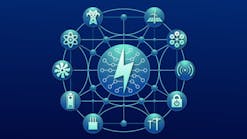As leading economies pivot towards renewables, for many the challenge lies in balancing the required power mix on an aged and under pressure grid – all while maintaining availability and factoring in an ever-unpredictable climate.
The energy transition is certainly on. Almost a third (29 percent) of the world’s energy supply already comes from renewable sources such as wind, solar and hydro. By, 2026 this figure will likely be equivalent to today’s fossil fuel and nuclear energy capacity combined.
While positive, the transition does present many challenges in how to integrate these new energy producers into existing grids.
Much of the current infrastructure that carries electricity supply into our homes, offices and factories is decades old. It was designed to deal with a steady, reliable supply of energy, under the basic assumption that the amount of electricity fed into the grid is always equal to the amount of electricity consumed.
Weather-dependent wind and solar energy sources are incredibly difficult to predict and add a new layer of complexity. If there is too much electricity and low demand, the electrical frequency increases. By design, this can cause power plants to disconnect from the grid. In the case of high demand and low availability, the frequency drops. This may prompt automatic load shedding, and in the worst-case scenario, it can cause a blackout.
In China, for example, as many as 20 provinces experienced power outages last year with the potential to affect up to 66 percent of gross domestic product, as the country struggled to balance electricity supplies with soaring demand. Similarly in the USA, power outages are estimated to cost the U.S. economy $150 billion annually.
How can we prevent this from happening and build better grid resilience?
One strategy to increase grid resilience is battery energy storage. New, advanced battery energy storage systems are quickly coming to the fore as a way for utilities and largescale industries to obtain backup power, decarbonize and manage energy efficiently.
Experts are predicting that energy storage installations will grow 20 times larger than 2020 levels by 2030.
At ABB, we believe this innovation is a critical component of local resilience and must play a lead role in enabling power system operators to average the load more accurately at the point of generation.
A great example of this can be found in the Philippines where solar power is widely seen as the best energy source to tackle the country’s over-reliance on imported fossil fuels.
However, introducing vast amounts of solar-generated energy into the grid required a different approach. In the case of the Philippines’ tropical climate, it is not unheard of to see extremely hot periods followed by sustained rain – making it incredibly important that the highs and lows of solar generation are accounted for.
This is seen as ABB and solar energy provider Solar Philippines recently collaborated on the 63.3 MW Calatagan Solar Farm in Batangas that will provide more than 400,000 people with sustainable energy.
The project, which was made possible with help from the Philippine government’s Feed-In Tariff (FIT) scheme, is one of the largest solar facilities on Luzon with 200,928 solar panels providing electricity to more than 413,000 people across six municipalities in Western Batangas.
To ensure continuous power supply, ABB provided the core Electrical Balance of Plant (eBOP) equipment, from the solar panel to grid connection, for the solar farm, with the bulk of battery energy storage units close to the transmission grid. This combination of low and medium voltage technology includes 23 2,400kVA and 13.8 kV skid-mounted modules, along with two bays of 69 kV substation equipment, 30 MVA 69 kV/13.8 kV power transformers, one modularized e-House with 14 frames of UniGear ZS1 switchgear with Relion protection relays and one set of protection and control panels.
The result is that daily shifts in supply and demand, along with the terrain’s changeable climate, can be balanced easily and instantly managed by simply adding a battery to the grid or charging it.
As an alternative, microgrid solutions are also gaining popularity, with the market forecasted to reach nearly $46.5 billion this year.
At its most basic level, a modern microgrid will usually involve renewable energy generation options such as solar panels and wind turbines, and some form of energy storage device, invariably a battery, to create a decentralized, self-sufficient energy hub.
A major benefit of this approach is that a microgrid can act as part of the wider grid while also being able to disconnect from it and operate independently, for example, in the event of a blackout.
In this way, it can help utilities to boost resilience and provide power during peak usage while working to modernize the existing grid infrastructure. Amid increased energy volatility, more businesses are turning to microgrids to safeguard them from the huge operational and financial implications of a power outage. It’s estimated that nearly 40 percent of utilities are receiving requests from companies for help implementing microgrids.
But its value isn’t confined to power backup solely. Local control of the microgrid means operators can be smarter about the energy they use, both on and off the grid, to improve the energy efficiency of buildings within it, reduce carbon emissions and lower costs.
The instability attributed to changes in the power generation mix and climatic extremes will continue to impact existing grid infrastructure. The emergence of battery energy storage and microgrids as a route to better resilience is inevitable, and now is the time to identify a pathway to a stronger grid for future generations.


